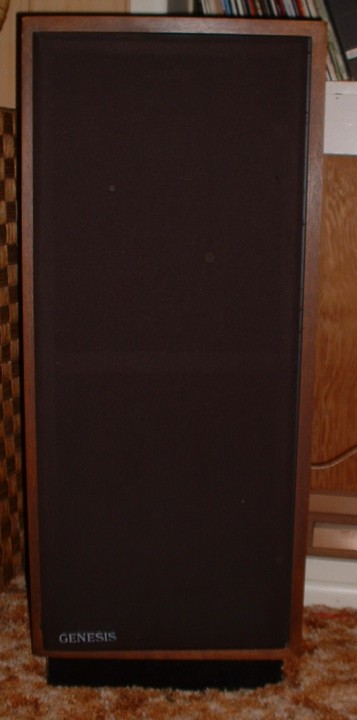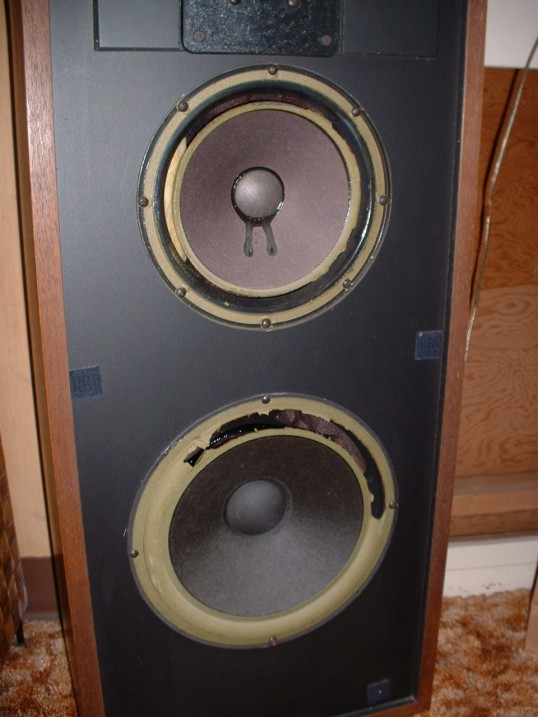Another adventure into the ancient history known as The '70s. Today I was listening to my old Boston record/LP "Don't Look Back", largely because Brad Delp just died. There's a track that has an incredibly low-frequency note, probably synthesized. As a lad, this fascinated me greatly as it would cause one's woofer to bounce around producing it (if it could reproduce it that is). Anyway, it started booming and I heard a rattling coming out of one speaker:

So I took off the cover and lo and behold, a piece of the rubber surround of the woofer was falling off! I touched it and the whole surround turned out to be dry and flaky and, sure enough, completely shot:

The woofer is the big one in the center; that cone on the bottom is a passive radiator; more about that later. Both cones had bad surrounds so basically the thing is shot. New speakers? Probably not. About 10-12 years ago one of my cats decided to have a go at the other one and ripped two of the cones in that one. At the time, I found someone in Phoenix who sold replacement parts for Genesis speakers. I eventually found this place which seems to be run by a former employee of Genesis Physics, not related to Genesis Loudspeakers who are making speakers now.
Yeah, in my youth I was a stereo freak. Not an "audiophile" since those are the high end snobs who will happily pay a couple hundred bucks for gold-plated connector cables despite their having never passed a blind listening test. (I can almost see the vituperative emails coming in now) I bought these Genesis 2+'s way back in 19mumble mumble and have dragged them around the country ever since. They still sound great so I plan on replacing either the surround material or the drivers.
To be honest, I don't think speaker technology has changed all that much since the '70s. The 1970s were probably the golden age of loudspeaker design and everything since is mostly, I think, a refinement of what was developed then. Genesis was founded by some guys who worked for EPI and left to form Genesis Physics. They made a great speaker for a reasonable price. Their main innovation was an inverted dome tweeter. They also used the passive radiator in some of them. Passive radiators got kind of a bad rap when they first came out because Panasonic used them in their cheapo speakers. Still, it was a good technology for getting those really low bass notes instead of a port; basically, as in the Wiki entry linked above, you could tune the speaker box to move the radiator based on the movement of the air by the woofer. Consequently, these suckers will rattle the house.
Back then, there was a lot of innovation going on and a lot of weird stuff coming out. Electrostatics were probably the best, but they suffered from a lack of bass. A lot of companies tried stuffing more and more drivers onto their speakers and I think Cervin-Vega ended up with like 70 each in one model. That one, incidentally, was the only speaker my stereo-geek store people ever said they couldn't tell from a live performance. C-V's were the rock-and-roller's best friend. Someone I knew had a pair of big 15"-woofer C-V's and we used to blast Foghat out of them. Yeesh. Show my age much?
There was also a weird one where the driver was sort of an inverted cone sitting at the top. Never heard one of those. I think my Ultimate Speakers back then were Acoustic Research AR-9's. There were also Dalquist Dq-10's that had 5-6 drivers each and they were all staggered because sound of different frequency reached the ear faster. By staggering them, they reasoned that all frequencies would reach you at once and that would somehow sound more natural. I did hear those once, but they didn't seem all that exciting.
I still have a soft spot for Advents which my friend Del had; very good speakers. That link is to a modern review of them. The person that does my hair bought some from a friend for her shop and I was soooo jealous. They look great, too.
As I said, speakers don't seem to have changed much. We were even playing around with surround sound then. You could hook up four speakers in serial around a room (which I did) and have a pseudo-surround sound going. I first bought some small speakers called Matrix which were actualy quite good for their size. Then I got a Hitachi cassette deck, and Onkyo amp, tuner, and turntable. And I still have them all! Although the Hitachi doesn't work. . . . .
And the big Bose controversy continues. Geez. The big rap against Bose has always been that they tend to use audio trickery to make the speakers sound better than they are. That is, they use sorta cheapo drivers and position them to reflect off of walls and stuff and make it sound like you're in a huge room, due to all of the reflecting. There's something to this, of course, and personally I find snobbery more than a bit off-putting. Still, I tend to have a reflexive dislike of Bose, influenced by the fact that I got roped into a Bose store for a half-hour infomercial. Used car salesmen, they are. They tend to market to those who have limited experience with audio, mostly people who have heard only small radio speakers with little bass or treble. Hence, you hear these things just filling up a room with sound and it's quite impressive. Some reviewers really liked them in some respects, and they did make a lot of room-filling sound. But once you listened to them (I'm talking about the classic Bose 901's here) for a while, you realize they sound pretty mushy, mostly because they only used a single type of driver for all frequencies.
So, eh, I'll see about getting new drivers and post an update once they go in. In the meantime, I'm listening to some old Jimmy Buffett LPs. I got turned on to Buffett on my field school on San Juan Island, WA. Talk about a cushy field school. We'd bomb around the island, drink (a lot), hang out at the beach, and pretend we were expat bums. Er, plus, I had a bit of a fling with a perfectly lovely young lady named Siendie. *sigh* Jimmy Buffett, archaeology, a touristy island, and a summer romance: sometimes it just all comes together.